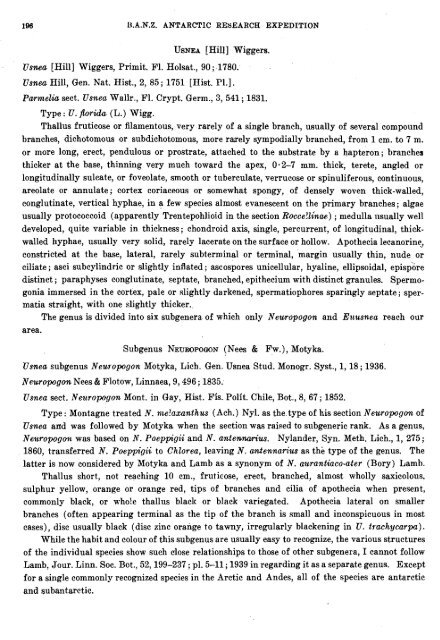You also want an ePaper? Increase the reach of your titles
YUMPU automatically turns print PDFs into web optimized ePapers that Google loves.
U.A.N.Z. ANTARCTIC RESEARCH EXPEDITION<br />
USNEA [Hill] Wiggers.<br />
Usnea [Hill] Wiggers, Primit. F1. Holsat., 90; 1780.<br />
Usnea Hill, Gen. Nat. Hist., 2, 85; 1751 [Hist. Pl.].<br />
Parnaelia sect. Usnea Wallr., F1. Crypt. Germ., 3, 541 ; 1831.<br />
Type : U. flo~idu (L.) Wigg.<br />
Thallus fruticose or filamentous, very rarely of a single branch, usually of several compound<br />
branches, dichotomous or subdichotomous, more rarely sympodially branched, from 1 cm. to 7 m.<br />
or more long, erect, pendulous or prostrate, attached to the substrate by a hapteron; branches<br />
thicker at the base, thinning very much toward the apex, 0-2-7 mm. thick, terete, angled or<br />
longitudinally sulcate, or foveolate, smooth or tnberculate, verrucose or spinuliferous, continuous,<br />
areolate or annulate; cortex coriaceous or somewhat spongy, of densely woven thick-walled,<br />
conglutinate, vertical hyphae, in a few species almost evanescent on the primary branches; algae<br />
usually protococcoid (apparently Trentepohlioid in the section Rocce!linw) ; medulla usually well<br />
developed, quite variable in thickness ; chondroid axis, single, percurrent, of longitudinal, thickwalled<br />
hyphae, usually very solid, rarely lacerate on the surface or hollow. Apothecia lecanorinc.,<br />
constricted at the base, lateral, rarely subterminal or terminal, margin usually thin, nude or<br />
ciliate ; asci subcylindric or slightly inflated ; ascospores unicellular, hyaline, ellipsoidal, epispore<br />
distinct ; paraphyses conglutinate, septate, branched, epithecium with distinct granules. Spermogonia<br />
immersed in the cortex, pale or slightly darkened, spermatiophores sparingly septate; spermatia<br />
straight, with one slightly thicker.<br />
The genus is divided into six subgenera of which only Neuropogon and Ewusnea reach our<br />
area.<br />
Subgenus NEUR~PO~ON (Nees & Fw.), Motyka.<br />
Usnea subgenus Newopogon Motyka, Lich. Gen. Usnea Stud. Monogr. Syst., 1,18; 1936.<br />
ATeuropogon Nees & Flotow, Linnaea, 9,496 ; 1835.<br />
Usnea sect. Nez~ropoyon Mont. in Gay, Hist. Fis. Polit. Chile, Bot., 8, 67; 1852.<br />
Type : Montagne treated N. nze!azanthtls (Ach.) Nyl. as the type of his section Neuropogon of<br />
Usnea arrd was followed by Motyka when the section was rai~ed to snbgeneric rank. As a genus,<br />
Nezcropogmt was based on hT. Poeppigii and N. antel~tarius. Nylander, Syn. Meth. Lich., 1, 275;<br />
1860, t~ansferred N. Poeppigii to Clzlorea, leaving N. antennarius as the type of the genus. The<br />
latter is now considered by Motyka and Lamb as a synonym of N. azcrantiaco-ater (Bory) Lamb.<br />
Thallus short, not reaching 10 cm., fruticose, erect, branched, almost wholly saxicolous,<br />
sulphur yellow, orange or orange red, tips of branches and cilia of apothecia when present,<br />
commonly black, or whole thallns black or black variegated. Apothecia lateral on smaller<br />
branches (often appearing terminal as the tip of the branch is small and inconspicuous in most<br />
cases), disc usually black (disc zinc orange to tawny, irregularly blackening in U. trachycarpa).<br />
While the habit and colour of this subgenus are usually easy to recognize, the various structures<br />
of the individual species show such close relationships to those of other subgenera, I cannot follow<br />
Lamb, Jour. Linn. Soc. Bot., 52,199-237 ; pl. 5-11 ; 1939 in regarding it as a separate genus. Except<br />
for a single commonly recognized species in the Arctic and Andes, all of the species are antarctic<br />
and subantarctic.

















